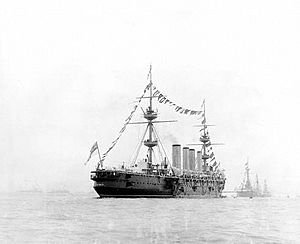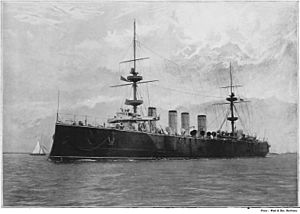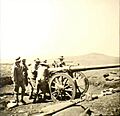HMS Terrible (1895) facts for kids
class="infobox " style="float: right; clear: right; width: 315px; border-spacing: 2px; text-align: left; font-size: 90%;"
| colspan="2" style="text-align: center; font-size: 90%; line-height: 1.5em;" | 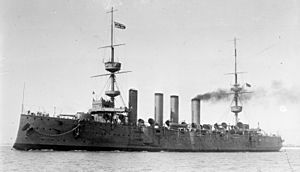
|}
HMS Terrible was a large warship, known as a protected cruiser, built for the Royal Navy in the 1890s. She was the second and last ship of her class, called the Powerful-class. Terrible saw action in two major conflicts: the Second Boer War in South Africa and the Boxer Rebellion in China.
During these times, her captain, Percy Scott, was famous for training his crew to be excellent at gunnery (shooting guns). His special training methods were so good that the entire Royal Navy started using them. After her active service, Terrible was used for various roles, including a training ship, before being sold for scrap in 1932.
| History | |
|---|---|
| Name | Terrible |
| Builder | J. & G. Thomson, Clydebank |
| Laid down | 21 February 1894 |
| Launched | 27 May 1895 |
| Completed | 24 March 1898 |
| Renamed | Fisgard III, August 1920 |
| Reclassified | Training ship, August 1920 |
| Fate | Sold for scrap, July 1932 |
| General characteristics (as built) | |
| Class and type | Powerful-class protected cruiser |
| Displacement | 14,200 long tons (14,400 t) (normal) |
| Length | 538 ft (164.0 m) (o/a) |
| Beam | 71 ft (21.6 m) |
| Draught | 27 ft (8.2 m) |
| Installed power |
|
| Propulsion |
|
| Speed | 22 knots (41 km/h; 25 mph) |
| Range | 7,000 nmi (13,000 km; 8,100 mi) at 14 knots (26 km/h; 16 mph) |
| Complement | 894 (designed); 799 (1916) |
| Armament |
|
| Armour |
|
| Top - 0-9 A B C D E F G H I J K L M N O P Q R S T U V W X Y Z |
Ship Design and Features
The Powerful-class cruisers, like HMS Terrible, were designed to be very strong and fast. They were built to counter a large Russian warship called Rurik, which was designed to attack trade ships. To do this, Terrible needed to be able to travel long distances and move quickly.
Size and Power
Terrible was a big ship, weighing about 14,200 tons. She was 538 feet (163.9 meters) long, 71 feet (21.6 meters) wide, and had a draught (how deep it sits in the water) of 27 feet (8.2 meters).
The ship was powered by two powerful triple-expansion steam engines. These engines used steam from 48 Belleville boilers. They could produce 25,000 horsepower, allowing Terrible to reach a top speed of 22 knots (about 41 kilometers per hour). She could travel about 7,000 nautical miles (13,000 kilometers) at a speed of 14 knots. Her crew usually consisted of 894 officers and sailors.
Weapons and Protection
HMS Terrible was well-armed for her time. Her main weapons were two large 9.2-inch (234 mm) guns, placed in single gun turrets at the front and back of the ship. For closer combat, she had twelve 6-inch (152 mm) guns. These were placed in armored sections called casemates along the sides of the ship. Some of these casemates were the first in the Royal Navy to have guns on two levels.
To defend against smaller, faster torpedo boats, Terrible carried sixteen 12-pounder (76 mm) guns and twelve 3-pounder (47 mm) Hotchkiss guns. She also had four underwater torpedo tubes, which could fire 18-inch (450 mm) torpedoes.
The ship was protected by strong Harvey armour. Her main deck was between 2.5 and 4 inches (64–102 mm) thick. The conning tower, where the ship was commanded, had very thick armor, 12 inches (305 mm) thick. The gun turrets and casemates also had 6-inch (152 mm) thick armor.
Building and Early Years
Terrible was built by J. & G. Thomson at their Clydebank shipyard. Her construction began on 21 February 1894, and she was launched on 27 May 1895.
After being launched, she went to Portsmouth Dockyard to be finished. In July 1897, she was temporarily put into service to take part in a special fleet review. This event celebrated Queen Victoria's Diamond Jubilee.
Terrible officially began active service on 24 March 1898. She made some important trips, carrying high-ranking officials to places like Gibraltar and Malta. In December 1898, she set a speed record while transporting crews to Malta, covering 2,206 nautical miles in just 121 hours, even in bad weather.
In March 1899, a boiler on the ship exploded, sadly killing one stoker and injuring three others. An investigation found that using salt water had caused corrosion and blockages in the boiler tubes, leading them to burst.
Boer War and Boxer Rebellion
In September 1899, Captain Percy Scott took command of Terrible. He was ordered to take the ship to the China Station. However, Scott believed that war was about to start in South Africa. He convinced the Admiralty to let him sail around the Cape of Good Hope instead of through the Suez Canal.
Helping in the Boer War
Terrible arrived at Simonstown on 14 October, just as the Second Boer War was about to begin. Since there was no threat from the sea, Captain Scott decided to help the army on land. The army lacked long-range artillery, so Scott came up with a clever idea: he adapted the navy's heavy guns by mounting them on wheels. This allowed them to be moved and used on land.
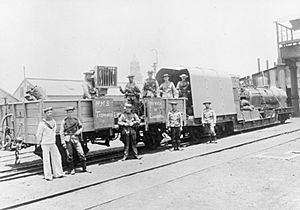
At first, the army authorities were suspicious of these homemade gun carriages. But they proved to be very effective! Two of Terrible's 4.7-inch (120 mm) guns played a crucial role in the Siege of Ladysmith, which received a lot of attention.
Terrible arrived in Durban on 6 November. A group of sailors from Terrible, known as a naval brigade, joined the force sent to relieve Ladysmith. They brought two 4.7-inch guns and eighteen 12-pounder guns. This naval brigade fought in battles like Colenso and Spion Kop. They helped relieve Ladysmith on 28 February 1900. Captain Scott also adapted a small searchlight to be used as a signal light on a train, helping to communicate with the besieged forces in Ladysmith.
Fighting in the Boxer Rebellion
After helping in South Africa, Terrible's crew returned to the ship, and she sailed for China, arriving in Hong Kong on 8 May 1900. Captain Scott quickly mounted four 12-pounder guns on field carriages. This was because he knew Terrible and her crew would be needed to help British forces against the Boxers, an anti-foreigner group in China.
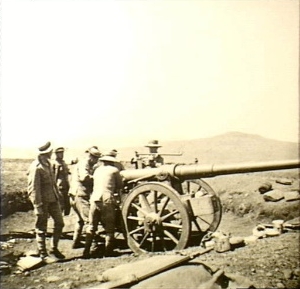
On 15 June, Terrible was ordered to take soldiers to Taku, arriving on the 21st. One of her 12-pounder guns went with the relief force that reached Tianjin on 24 June. The other three guns helped defeat Chinese forces in the city of Tianjin in mid-July. All four guns were part of the second relief expedition to Beijing in August. Her crew returned to the ship on 7 September.
After the fighting, Captain Scott focused on improving his ship's gunnery skills. He created new training tools, and his crew achieved excellent shooting scores. In 1900, they scored 78.8%, and in 1901, they scored 80%, the best in the entire Navy!
In early 1902, Terrible spent several months in Hong Kong. She helped the dockyard by providing relief and condensed water during a cholera outbreak and water shortage. In July 1902, Terrible was ordered back to Britain. She returned to Portsmouth on 19 September. Upon her return, 700 of her crew were honored at a public dinner. She was then taken out of service on 24 October for a long refit (major repairs and upgrades). During this refit, four more 6-inch guns were added to the ship.
Later Years and Fate
Terrible was recommissioned on 24 June 1904 for special service. She carried relief crews to the China Station and returned in December. She was then placed in the reserve fleet.
In August 1905, she was reactivated to escort the battleship Renown, which was carrying the Prince and Princess of Wales (who would later become King George V and Queen Mary) during their tour of India. She returned home in early 1906.
Terrible served as a temporary flagship (the ship carrying the commander of a fleet) during naval exercises in June and July 1906, then went back to reserve. She was reactivated again in November to ferry more relief crews to China. On her way back, she lost a propeller and had to finish the journey on one engine.
The ship underwent another refit from May 1908 to April 1909. After this, she was assigned to the Fourth Division of the Home Fleet. From July 1909, Terrible was mainly used as an accommodation ship, providing living quarters for sailors. In December 1913, she was moved to Pembroke Dock.
In July 1914, just before the First World War began, Terrible was listed for sale. However, the sale was cancelled when the war started. In September 1915, she was recommissioned to transport troops to the Dardanelles Campaign. Her large 9.2-inch guns were removed for this purpose. She reached Mudros on 2 October.
Upon her return, Terrible became a depot ship at Portsmouth. In January 1918, she was assigned as a tender (a support ship) to HMS Vernon, and a year later, to HMS Fisgard.
In September 1919, Terrible was hulked. This meant she was disarmed and most of her engines were removed. She was converted into a training ship for engineering apprentices. When this conversion was finished in August 1920, she was renamed Fisgard III.
When the Fisgard training establishment moved to land-based buildings, the ship was put up for sale in January 1932. She was bought in July by John Cashmore Ltd for scrap. Terrible was towed to Newport, Wales in September and broken up. Parts of her teak wood were later made into souvenirs and sold.
Images for kids
-
Scott's improvised signal light
-
A 12-pounder gun on one of Scott's carriages in Natal, South Africa


